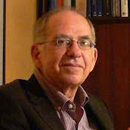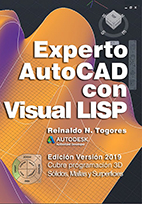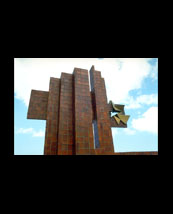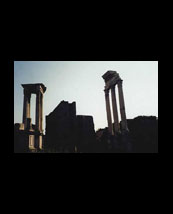 Arch of Septimius Severus, Arch of Septimius Severus,Roman Forum. 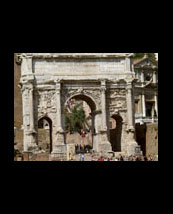 Temple of Castor and Pollux, Temple of Castor and Pollux,Roman Forum. 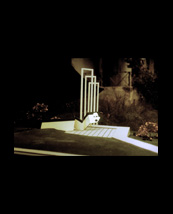 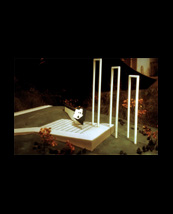 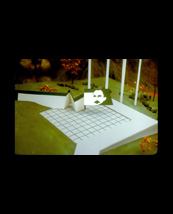 Martí-Rome Martí-RomeOriginal proposal. 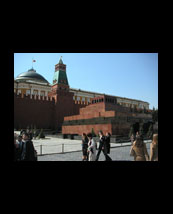 Lenin Mausoleum Lenin MausoleumRed Square, Moscow. 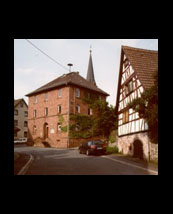 German Town Hall. German Town Hall.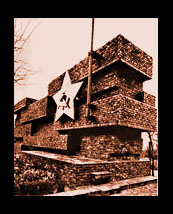 Monument to Rose Luxemburg Monument to Rose Luxemburgand Karl Liebknetch. 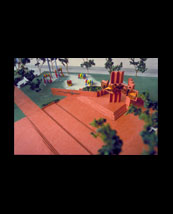 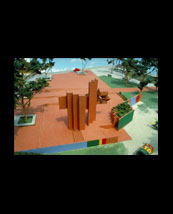 | Reinaldo N. Togores Part IIIIn monuments utilitarian aspects are put aside. Instead of operating solely from a program of functional requirements one must fulfill what might be called, according to Jencks, a 'symbolic program'... This symbolic program shall not be conceived as a detailed script in which a story is told. It rather consists in a series of suggestions which operate as the seed around which a host of associated ideas crystallizes. I will refer in the first place to the José Martí monument in Rome designed in collaboration with the Sculptor Tomás Lara (24). In this case the starting point was a phrase suggested byhistorian Pedro Alvarez-Tabío: 'I want the first law ofour republic to be the respect of Cubans to the full dignity ofMan' (25). This statement highlights a facet of Marti's personality, that of the man of law, both from trainingas from vocation.The archetype of our modern codes of law is found in Roman Law. This idea evokes in us, immediately, the place of law: the Roman Forum. From the colonnades that once surrounded it only remains have endured. Just two or three shafts, here and there, supporting pieces of entablature. Of those vestiges of the ancient forum sprouts a first image, a slender portico that reproduces the proportions of intercolumnia in ancient basilicas. The space defined by this structure can also be read as door. Doors, colossal doors, were precisely the memorials of the great feats in Roman antiquity. In triumphal arches the door motif is often reiterated triplicating it. Doors invite the passage therethrough, marking a path. The direction of travel is emphasized by establishing a sequence in depth and height.Life, and in particular that of someone like Martí can be seen as a path, a path which is traversed despite the obstacles encountered. The path defined by the succession of porticoes must overcome the terrain's slope and the steepness of the foundation to find, lastly, the wall against which it crashes. Fitting conclusion to the path of he who claimed 'let the Star That illuminates and kills brightly glow on my brow'(26). On the impact, the wall shatters, its sharp planes shifting in a flurry in which they could become a star, but a flag as well. Martí, on reaching his destiny -the star- becomes the flag. The wall with his image, shatters, the rises to the wind, fluttering as should have the cavalry banners in that action in which he met his death. From Martí, the man of law, we arrived in this flow of images to Martí, a flag. From the political project of a republic to the personal destiny of a man. This monument remained a project. Local authorities, perhaps because of political color changes, delayed its approval with a number of objections that were the reason for two additional project variants. Eventually conditions were established from which the monument was reduced to a two meters high stela. The idea of the porches abandoned, the topic of the star remains, suggested from the intersection of planes. The original intention of using white and green marble was objected as well by the local authorities because of the danger of the omnipresent graffiti. The material used at the request of the zone's chief engineer will undoubtedly facilitate the work of city employees but introduces, with that star in red granite, suggestions perhaps appropriate to the ideological affiliation of our current government, but certainly foreign to the conservative officials that, taking into account only the functional aspect, promoted its use. Red, used this time quite deliberately, is the protagonist in the plaza and monument dedicated to the memory of Lazaro Peña designed in collaboration with sculptors Juan Negrín and Rene Quintanilla (27). The meaning of a color is not independent of the quality of the material to which it belongs. The rather Soviet appearance of the star suggested in the Rome Memorial is derived both from the red color as from the fact that the material is granite, exotic material for us and certainly linked in our memory to the Red Square mausoleum. When choosing the material for this other project we rejected 'luxury' materials preferring instead a 'poor' material such as clay tile. Fired clay has, although 'poor', a peculiar nobility. It has accompanied man since his very origin as industrious and thinking being. Not without reason it was the material chosen by the creator, according to the Bible, for his masterpiece: man himself. The action of a militant worker such as Lazaro Peña, on the other hand, is rooted in a 'German Ideology' such as that of Marx and Engels. To the austerity that is characteristic of this philosophy corresponds the architecture of the old red brick town halls in northern Germany, architecture that according to Weigert: "creates a secular symbol for the city, not a sacred one as the church. It is austere, poor and rude, reflection of a way of life that is not concerned... with the adornment of existence, with its pleasant accessory aspect, but cares only of the function, of the service of the whole and of the individual [subordinated to] this whole, in which the part represents nothing." (28). Within this tradition the choice of brick as the material for the Rosa Luxemburg and Karl Liebknetch monument made by the German Mies van der Rohe in the twenties is surely inserted. Our project, taking into account the multiple links with streets, buildings and neighborhood parks, including a playground located in the same block (29), and taking into account the site's topography and the existing trees, establishes a continuity of pathways that converge in a center which becomes square, podium and monument. The red tile facing is used both for the pavement and the vertical surfaces that make up the central structure. This reinforces its democratic character, in the sense that it comes from 'below', and down as well, close to the base from which a good labor leader would never be estranged, the relief depicting Lazaro Peña is inserted. The walls also grow in height are staggered in depth, whereby with reference to the main directions in which our perception of space is structured, vertical and horizontal, we can say that in addition to coming 'from below', they come 'from behind'. That is, they advance, after the manner of the successive human waves which once expressed their demands in street demonstrations. The walls, on escalating, unfold in the manner of the red flags those crowds wielded. The image of the star, enduring symbol of patriotic struggles, also reappears as the culmination of this whole, rendered from metallic planes that intersect and recompose revealing its identity step by step. This relief applied to the staggered walls structure contributes, with its symbolism, to clarify the meaning of the whole. Already we have referred to ornament's symbolic role and its proscription within the framework of functionalist conceptions. Now we have a return to the ornamental application as an element whose redundancy is due to a purpose that although it may seem contradictory, is strictly functional: to achieve a most accurate communication. This is of utmost importance. The structural may not always rise to a rank of aesthetic significance. Economy may force us to solutions far apart from the drama of environment transforming 'high-techs'. Especially today, when we wake up to the harsh reality understanding that it is not possible to continue with the waste of resources they entail. It is about the steel, cement, fuel, equipment and spare parts that, or we can no longer continue importing or that we could use more profitably in other endeavors. Turning away from the old and discredited myths it becomes necessary to rediscover our only constantly renewed resource: our men and women's will to work. Will which shall find its way in an alternative solution. The one imposed as a significant cultural phenomenon notwithstanding the use of the same materials, suffering the same shortages and counter to one and the same bureaucratic hierarchy always eager to prevent the uncommon. Robert Venturi pointed out a possible alternative, the 'decorated shed' whose significance lies not in the expression of tectonic processes nor in the rarity and value of the natural or artificial materials, but in the imaginative wealth and consecrated craft revealed in its ornament. With pleasure we would subscribe objectives as those proposed, according to Portoghesi, in the work of Venturi: "slightly tweak the conventional elements of the urban landscape, profoundly changing the context and obtaining maximum results with minimum effort. It is a reformism without illusion but lucid, opposed to the capriciousness... which has reduced architecture to a desert of unrealized good intentions" (30). The way back from this desert is not easy. We have lost our mastery on the craft of building. It is not only the will to do what we must demand ourselves, but also the knowledge of how to do it. Today, when overcoming the functionalist dogma allows us to recover the richness of a language without inhibitions, of an eclecticism with new clarities, the craft of our carpenters, blacksmiths, and masons must grow hand in hand with the ingenuity of our architects and designers. Certainly, we now envision an era ruled by the understanding that Architecture, its name capitalized as befits one of the fine arts, is above all the free invention of environment and its ornament for man's greatest delight. Havana, April 26, 1991 |
